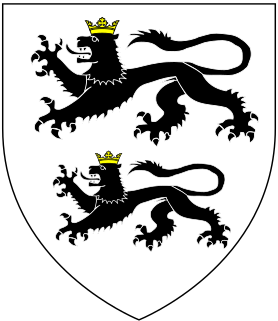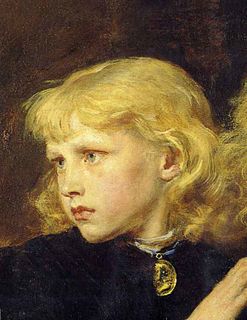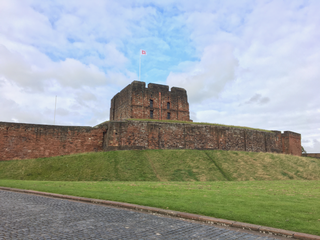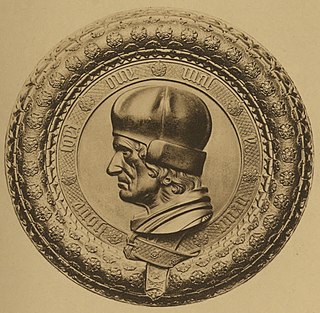
Sir Richard Ratcliffe, KG (died 22 August 1485) was a close confidant of Richard III of England.

Sir Richard Ratcliffe, KG (died 22 August 1485) was a close confidant of Richard III of England.
Ratcliffe came from a gentry family in the Lake District, and became a companion of Richard when the latter was still Duke of Gloucester (1461–83). He was one of Richard's trustees in the lordship of Richmond, and was named steward of Barnard Castle. Richard, while Duke of Gloucester, knighted Ratcliffe during the Scottish campaigns, at the same time creating him a knight banneret. [1]
During the seizure of power by Richard III, Ratcliffe was chosen to return to the north and organize an army to help the Protector, as Richard III was then titled. Some sources name Ratcliffe as the person who gave the order to execute Anthony Woodville, 2nd Earl Rivers (beheaded Jun 1483). [1]
When Richard became king he gave Ratcliffe a number of offices, including the currently attainted hereditary High Sheriff of Westmorland, and made him a Knight of the Garter. He also received a large grant of lands, including much that had belonged to the Courtenay Earls of Devon. After the rebellion of 1483 he was given a very large number of forfeited estates. As a result, he had an income larger than most barons. [1]
In July 1484, William Collingbourne, a Tudor agent, nailed a lampooning poem to St Paul's Cathedral, London, which obliquely identifies Ratcliffe as one of the three aides to King Richard:
The Catte, the Ratte and Lovell our dogge rulyth all Englande under a hogge.
The "catte" alludes to William Catesby; the "ratte" to Ratcliffe; and "Lovell" to Francis, Viscount Lovell, one of whose heraldic family devices was a white wolf (the "dogge"). The "hogge" alludes to King Richard and his badge of a white boar. [2] [3] The poem was interpolated into Laurence Olivier's film Richard III , a screen adaptation of Shakespeare's play.
Ratcliffe married Agnes Scrope, daughter of Henry Scrope, 4th Baron Scrope of Bolton, one of the great barons in the north of England.
Ratcliffe was one of the two councillors (the other was William Catesby) who are reputed to have told the king that marrying Elizabeth of York would cause rebellions in the north. [4]
Ratcliffe was killed at the Battle of Bosworth Field, on 22 August 1485. [1]
Ratcliffe appears in William Shakespeare's play Richard III as a minor character who executes Rivers, Grey and Vaughn. [5] In the Andrew Wise 1597 (first) edition, Sir Richard's character appears first as Sir Richard Ratliffe (without the 'c') then as plain Ratcliffe (with the 'c', but no 'Sir' nor 'Richard') and finally as plain Ratliffe. [6]
In the 1995 film version (starring Ian McKellen, and adapted to a 1930s setting), Ratcliffe is portrayed by Bill Paterson, and acts as (King) Richard's batman.

Richard III was King of England and Lord of Ireland from 26 June 1483 until his death in 1485. He was the last king of the House of York and the last of the Plantagenet dynasty. His defeat and death at the Battle of Bosworth Field, the last decisive battle of the Wars of the Roses, marked the end of the Middle Ages in England. He is the protagonist of Richard III, one of William Shakespeare's history/tragedy plays.

Thomas Stanley, 1st Earl of Derby, KG was an English nobleman. He was stepfather of King Henry VII of England. He was the eldest son of Thomas Stanley, 1st Baron Stanley and Joan Goushill.

Richard III is a play by William Shakespeare. It was probably written c. 1592–1594. It is labelled a history in the First Folio, and is usually considered one, but it is sometimes called a tragedy, as in the quarto edition. Richard III concludes Shakespeare's first tetralogy and depicts the Machiavellian rise to power and subsequent short reign of King Richard III of England.

Francis Lovell, 9th Baron Lovell, 6th Baron Holand, later 1st Viscount Lovell, KG was an English nobleman who was an ally of King Richard III during the War of the Roses. Sir William Catesby, Sir Richard Ratcliffe and he were among Richard's closest supporters, famously called "the Cat, the Rat and Lovell our dog" in an anti-Ricardian squib. In addition to being an ally, Lovell is described as Richard's best friend.

William Catesby was one of Richard III of England's principal councillors. He also served as Chancellor of the Exchequer and Speaker of the House of Commons during Richard's reign.

William Hastings, 1st Baron Hastings KG was an English nobleman. A loyal follower of the House of York during the Wars of the Roses, he became a close friend and one of the most important courtiers of King Edward IV, whom he served as Lord Chamberlain. At the time of Edward's death he was one of the most powerful and richest men in England. He was executed following accusations of treason by Edward's brother and ultimate successor, Richard III. The date of his death is disputed; early histories give 13 June, which is the traditional date.
Sir Robert Brackenbury was an English courtier, who was Constable of the Tower of London during the reign of Richard III. He is believed to have been responsible for enabling the (presumed) murders of the Princes in the Tower, though there is no conclusive evidence to prove it. He died defending the King at the Battle of Bosworth Field in 1485.

Ralph Neville, 1st Earl of WestmorlandEarl Marshal, was an English nobleman of the House of Neville.

Richard of Shrewsbury, Duke of York, was the sixth child and second son of King Edward IV of England and Elizabeth Woodville, born in Shrewsbury. Richard and his older brother, who briefly reigned as King Edward V of England, mysteriously disappeared shortly after Richard III became king in 1483.

Carlisle Castle is in Carlisle, in the English county of Cumbria, near the ruins of Hadrian's Wall. The castle is over 900 years old and has been the scene of many historical episodes in British history. Given the proximity of Carlisle to the border between England and Scotland, it has been the centre of many wars and invasions. During the Jacobite Rising of 1745–6, Carlisle became the last English fortress to undergo a siege. The castle was listed as a Scheduled Ancient Monument on 7 August 1996.

Richard III is a 1955 British Technicolor film adaptation of William Shakespeare's historical play of the same name, also incorporating elements from his Henry VI, Part 3. It was directed and produced by Laurence Olivier, who also played the lead role. Featuring many noted Shakespearean actors, including a quartet of actors who were later knighted, the film depicts Richard plotting and conspiring to grasp the throne from his brother King Edward IV, played by Sir Cedric Hardwicke. In the process, many are killed and betrayed, with Richard's evil leading to his own downfall. The prologue of the film states that history without its legends would be "a dry matter indeed", implicitly admitting to the artistic licence that Shakespeare applied to the events of the time.
The Lord Warden of the Marches was an office in the governments of Scotland and England. The holders were responsible for the security of the border between the two nations, and often took part in military action. They were also responsible, along with 'Conservators of the truce', for administering the special type of border law known as March law.

Henry Scrope, 3rd Baron Scrope of Masham KG, also known in older sources as Lord Scrope was a favourite of Henry V, who performed many diplomatic missions. He was beheaded for his involvement in the notional Southampton Plot to assassinate the king. Some historians believe that the charge was trumped-up to punish him for other acts of disloyalty, and that there may never have been such a plot.

Cecily of York, Viscountess Welles was an English princess, the third daughter of Edward IV, King of England, and his queen consort Elizabeth Woodville, daughter of Richard Woodville, 1st Earl Rivers, and Jacquetta of Luxembourg. She was First Lady of the Bedchamber to her sister, Queen Elizabeth of York, in the years 1485–1487.

Sir Thomas Lovell, KG was an English soldier and administrator, Speaker of the House of Commons, Secretary to the Treasury and Chancellor of the Exchequer.
Events from the 1480s in England. This decade marks the beginning of the Tudor period.
William Collingborn was an English landowner and administrator. He was an opponent of King Richard III – corresponding with his enemies and penning a famous lampoon – and was eventually executed for treason.

John Scrope, 5th Baron Scrope of Bolton, KG was an English Yorkist nobleman.

Sir Gilbert Talbot of Grafton, KG, was an English Tudor knight, a younger son of John Talbot, 2nd Earl of Shrewsbury and 2nd Earl of Waterford, and Elizabeth Butler.
John la Zouche, 7th Baron Zouche, 8th Baron St Maur (1459–1526) was a Yorkist nobleman and politician. He was noted for his loyalty to Richard III, under whose command he fought at the Battle of Bosworth, where Richard was killed. Under the victorious Tudor dynasty he suffered attainder and forfeiture of his property, but he was eventually restored to royal favour, due partly to a marriage connection to the new King's mother.